How Many Doctors Were Called Up For D-day Service
By Joshua Shepherd
As their landing craft plunged through heavy surf on the morning of June vi, 1944, it was obvious to the men of Company A, 116th Infantry Regiment, U.S. 29th Infantry Division that the coming 60 minutes would be the gravest test of their lives. Assigned to the start wave of assault troops landing on Omaha Beach's Dog Dark-green sector, the troops were the spearhead of a massive Allied invasion aimed at breaking Hitler'south Atlantic Wall.
As the landing arts and crafts approached the beach, the soldiers inside could hear the telltale sound of auto-gun rounds hit the raised ramps. Private George Roach recalled that he and his fellow soldiers were well aware that their assignment to the first wave would result in heavy casualties. "We figured the chances of our survival were very slim," recalled Roach.

At half-dozen:xxx am the landing craft conveying Visitor A quickly closed the altitude to the beach. When it was virtually 30 yards offshore, the flat-bottomed vessel struck a sandbar. Every bit the ramps were lowered, the troops were fully exposed to the fury of the German machine guns. Many of the first men who exited the landing craft were slain by car guns positioned to take interlocking fields of fire. Their lifeless bodies toppled into the water. Some men chose in their desperation to jump overboard instead of exiting the front of the arts and crafts. Once in the water where they were weighed down with their equipment, they faced a life-and-expiry struggle to keep their heads above water. They thrashed about while strapped to heavy loads. Those who could not go free of the loads drowned.
Struggling frontwards through a hail of machine-gun and shellfire, the survivors desperately sought cover behind tank obstacles placed by the Germans. Enemy positions were well concealed, and the hapless riflemen of Company A, unable to effectively fight back, cruel in mangled heaps. Terrified and demoralized, the dark-green troops of Company A had entered the worst killing zone on Omaha Embankment. "They're leaving us here to die similar rats!" screamed Individual Henry Witt in a higher place the steady roar of enemy fire.
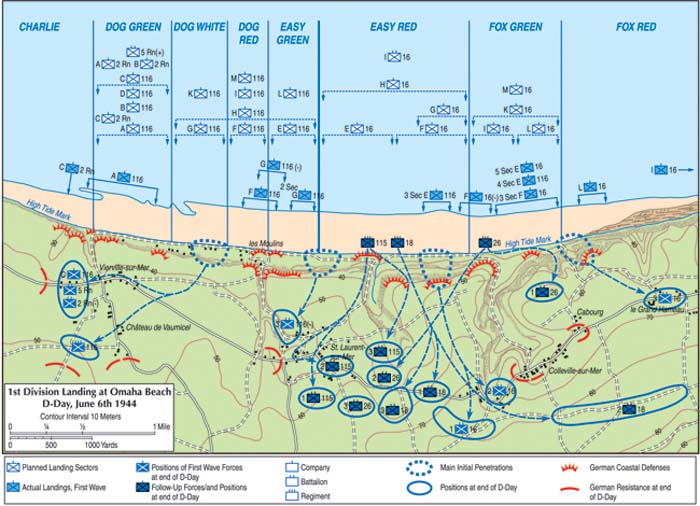
Since Germany's declaration of war on the United States on December eleven, 1941, an Allied assault against continental Europe was inevitable. Commencement with Operation Torch, the Allied invasion of N Africa in November 1942, the Allies maintained their momentum confronting the 3rd Reich with landings in Sicily and Italian republic in 1943. In this way, Anglo-American forces dilapidated away at the edges of an overextended Nazi empire.
But perhaps the greatest prize of the war remained occupied France. If the Allies could establish a beachhead, they would take an platonic path to the Ruhr industrial region of western Federal republic of germany. In March 1943 the Allies selected British Lt. Gen. Sir Frederick Morgan to serve as chief of staff to the Supreme Allied Commander, or COSSAC. Morgan and his staff immediately set to work developing preliminary plans for an invasion of France.
Formulating a workable scheme for what promised to exist the largest invasion in military machine history was a herculean logistical endeavor. Morgan's staff performed the unheralded but vital task of number crunching that would be done on a monumental calibration. Centrolineal planners determined the number of troops, tanks, and aircraft needed for such an operation. They tabulated men and matériel in excruciating detail. Individual supplies numbering in the millions, ranging from ammunition, rations, medicine, tires, and boots, would enable a modern army to bear the state of war to occupied French republic.
Morgan further assessed the suitability of landing sites in the far reaches of Western Europe. Although an intuitive guess would place an Centrolineal landing somewhere on the north coast of France, Allied planners explored the possibility of launching an invasion anywhere from Denmark to the Spanish border. From a practical standpoint, though, Centrolineal planners focused on northern France, which possessed suitable beaches on the Pas-de-Calais and Normandy coasts.
The Pas-de-Calais region, situated a mere 20 miles from Britain, was a superficially inviting target. Whatever invasion there would promise a quick crossing of the English Channel, could be well supported by Centrolineal air forces, and would find beaches suitable for an amphibious landing. Yet it became alarmingly articulate from Centrolineal reconnaissance flights that the enemy expected an assault on the Pas-de-Calais. Because of this the Germans had constructed superb fortifications in the region, making information technology the most heavily dedicated sector in occupied France.
Allied planners, therefore, chose the coast of Normandy for the landings. Although reaching Normandy would crave a 100-mile crossing of the choppy and unpredictable English Channel, a series of beaches stretching west of Caen would afford platonic sites for initial landings. Furthermore, Allied planners believed that the port of Cherbourg, situated just westward of the proposed landing sites, could be seized in short society and provide the Allies a deep-water port for the resupply of invasion forces. Only as of import, the Normandy declension appeared to be lightly dedicated by second-charge per unit German language conscripts.
Morgan'south staff set in move in late 1943 an epic and irreversible course of events for what became known as Operation Overlord. Although the massive buildup of men and supplies proved to be a frustratingly slow process, the Russians were loudly clamoring for the Allies to open a 2nd front confronting Nazi Germany. The leaders of the three primary Centrolineal powers—the Us, Great U.k., and the Soviet Union—held a series of strategy meetings starting time November 28 in Teheran, Iran. At the meetings the three leaders hammered out a strategy to open up a new front and assist the difficult-pressed Russians.
Soviet leader Joseph Stalin was deeply suspicious of the intentions of U.Southward. President Franklin Roosevelt and British Prime Minister Winston Churchill. The Germans had badly mauled Russian forces on the Eastern Forepart in the two years following the launch of Functioning Barbarossa on June 22, 1942. In particular, Stalin was annoyed that the Allies had non yet named a supreme commander to oversee the planned Anglo-American invasion of France. To bear witness good religion, Roosevelt announced in the wake of the conference that U.S. General Dwight D. Eisenhower would serve every bit the supreme commander for Performance Overlord.
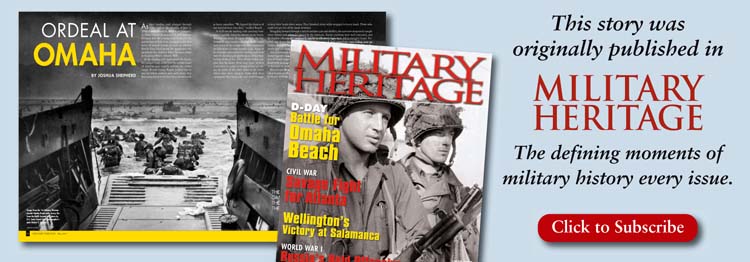
While the Allies planned the Normandy landings the loftier command of the German Regular army, known as Oberkommando der Wehrmacht, put its talented military engineers to work hardening the coastal defenses of northern France. Legions of German and French laborers worked tirelessly with pick and shovel to construct one of the most imposing defensive lines in history.
Stretching from the tip of Jutland to the border of neutral Spain, the Germans erected a series of fortifications known collectively as the Atlantic Wall. They used millions of cubic yards of steel-reinforced concrete to build fortresses, bunkers, and pillboxes. Dedicated past nearly a one thousand thousand men, the Atlantic Wall by mid-1944 bristled with heavy artillery, mortars, and machine guns.
The Germans had bully difficulty, however, finalizing their strategy for defending against Functioning Overlord. While the Atlantic Wall was being congenital, a major disagreement arose between Field Marshal Gerd von Rundstedt, the supreme commander of German forces in Western Europe, and Field Align Erwin Rommel, the commanding officer of Army Group B overseeing the German forces in northern France.
Rundstedt favored a measured approach to confronting a possible invasion. The senior commander believed that the powerful guns on Allied warships would furnish a protective umbrella for the Allied units coming aground. When the Allies had moved inland beyond the protective cover of the naval guns, the German panzer formations could maneuver in such a style that they would accomplish a decisive victory over the Allies.
For his part, Rommel believed it was imperative to contain the Allies on the beaches. He believed that the Allies' clear advantage in tactical air power would brand it impossible for the German panzer formations to maneuver as set along in Rundstedt's strategy. If the Allies were immune to constitute a business firm foothold on the beaches, Rommel feared they would win the state of war in France considering of their overwhelming advantage in men and matériel. "The high-h2o line must be the primary fighting line," said Rommel.
The disagreement was compounded by meddling by German leader Adolf Hitler. He insisted on retaining directly control of Federal republic of germany's armored and mechanized reserves in French republic. This meant that Rommel would need Hitler'due south authorization to commit the iv armored divisions that constituted the Wehrmacht's strategic reserve in France. The armored divisions were billeted hundreds of miles from the coast.
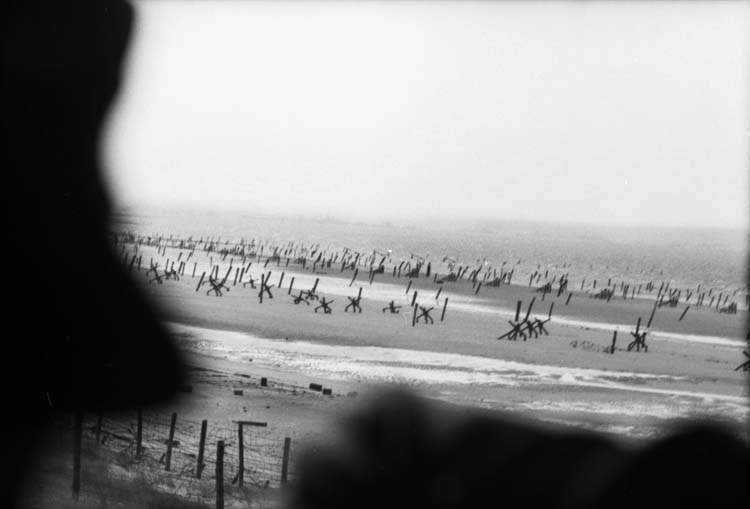
Eisenhower did not accept a strategic disharmonize similar to that the High german generals faced because he had been given greater strategic authority than his German counterparts. He was well suited for the job at manus considering of his tireless devotion to duty and his exemplary strategic and administrative skills.
Built-in in Texas, but raised in Kansas, Eisenhower graduated from West Bespeak in 1915. Although he lacked gainsay feel in World War I, he was an accomplished staff officer who earned high praise from his superiors. Many of his contemporaries, including General Douglas MacArthur, considered Eisenhower to be the best officer in the U.Due south. Army at the fourth dimension. "When the next war comes, he should go right to the summit," said MacArthur.
MacArthur was correct. Eisenhower led Performance Torch, the Allied invasion of North Africa in November 1942. Afterward that, he allowable the subsequent Allied forces during the invasion of Sicily and southern Italian republic in 1943. Eisenhower was pop with U.S. officers and enlisted men and with his counterparts in the British Army. After being appointed supreme commander, he tackled Operation Overlord with an inspiring blend of confidence and eagerness.
The Allies steadily built up their forces in England in the months leading up to the invasion of French republic. The invasion was possible in large part because of the industrial might of the Us. Factories and shipyards churned out ships, tanks, and trucks, while logistics personnel stockpiled mountains of matériel and rations needed to sustain the troops. Fields and subcontract lanes throughout England were used as temporary storage sites. Security throughout England was tight, even though it was impossible to completely shield the preparations from German reconnaissance planes.
Allied technological innovation likewise was on full display. 1 of the near vital recent inventions was the Landing Craft, Vehicle Personnel (LCVP). Congenital by Higgins Industries, the landing craft was more commonly known as the Higgins gunkhole. The Higgins gunkhole was a shallow-typhoon, plywood vessel designed for amphibious landings. Capable of carrying xxx assail troops and their gear, the Higgins boat played a crucial role in the Normandy landings.
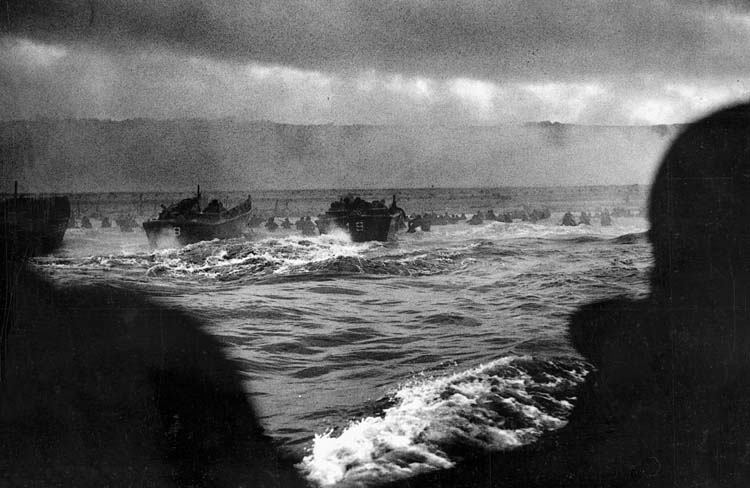
The U.South. Ground forces intended to use a curious apparatus to go its armor aground. First developed for British forces, the duplex drive (DD) amphibious tank consisted of a collapsible canvas shroud that transformed a 33-ton M4 Sherman tank into an amphibious vehicle. By raising the sheet shroud and using the tank's engine to power twin propellers, the DD system would give the infantrymen close armor support on the Normandy beaches. To ensure that it performed as intended, the Allies put the DD through rigorous amphibious exercises off the English coast. Although the DD organization performed flawlessly in the tests, they were conducted in relatively calm waters. Whether they would perform every bit well in rough waters was unknown.
Final plans called for burdensome firepower to be brought to comport straight on enemy positions before the landings. The U.S. Army Air Corps intended to deport saturation bombing of German language coastal positions in Normandy in the hope that the daunting fortifications of the Atlantic Wall might exist softened up before the infantry hit the beaches. Once the bomber crews had washed their job, Allied surface ships would swing into action, pounding littoral defenses into submission. Landing Craft Tank (Rocket) platforms would so contribute their firepower in the form of rocket salvos intended to keep the enemy hunkered downwardly while the landing craft sped to shore. With whatever luck, the crush-shocked German language defenders would be quickly overrun.
All told, the Allies would land simultaneously on five beaches, forever immortalized by their iconic code names. To the eastward, British and Canadian troops would strike 3 landing sites. From left to correct, the British 3rd Partitioning would attack Sword Beach, troops of the 3rd Canadian Division would attack Juno Embankment, and the British 50th Division would seize Aureate Beach.
In the American sector to the westward, the 1st U.S. Army under the command of Lt. Gen. Omar Bradley was assigned 2 landings sites. On the Allied far correct, the 4th Infantry Division would attack at Utah Embankment, where it would be in a position to cut across the neck of the Cotentin Peninsula and isolate the vital port city of Cherbourg. To its left, elements of the 29th and 1st Infantry Divisions would strike a six-mile-long stretch of sand flats known as Omaha Beach. Each assault visitor on Omaha Beach was assigned to 1 of eight sectors: Charlie, Dog Green, Dog White, Dog Red, Easy Light-green, Like shooting fish in a barrel Scarlet, Play tricks Greenish, and Play tricks Carmine.
Allied planners expected Omaha Beach would prove to be the nigh difficult landing of the Normandy invasion. Landing at low tide, set on troops would confront a dizzying maze of German obstacles before they reached dry out ground. The shallows bristled with wooden stakes tipped with mines and steel hedgehogs. The and so-called Czech hedgehogs were antitank obstacles made of metal angle beams or I-beams designed to tear the bottom of boats at high tide. As the men moved forward, the only comprehend bachelor would be a sparse natural bank of stones called shingle. Washed aground for millennia by the waves of the English Channel, the shingle embankment was no more than three anxiety loftier. Across the shingle lay a daunting no-human'southward country of dour sand, which was 300 to 400 yards deep with no protection. The Germans had 85 auto-gun positions to sweep Omaha Embankment.
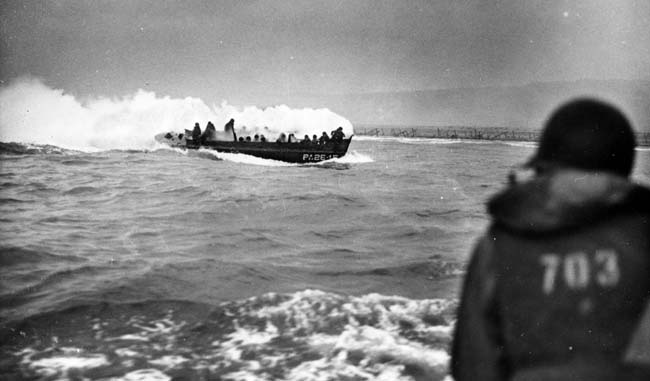
In one case the sand flats were successfully negotiated, troops would encounter a 5-foot seawall topped by a almost impassable bulwark of tangled barbed wire. Sheer bluffs rise 100 feet commanded the entire beach. The bluffs were sewn with mines and crowned by some of the most formidable concrete bunkers of the Atlantic Wall. Centrolineal planners had instructed the infantry assaulting Omaha Beach to secure five "draws," which were passages through the bluffs. The only manner the armor could get off the beach was through the draws.
The troops were cautiously optimistic that they would face relatively weak resistance at Omaha. Allied intelligence indicated that the German 716th Partition, an inexperienced 2nd-rate unit composed of conscripts from occupied parts of Poland and Russia whose morale was believed to be poor, would put upwardly merely token resistance.
Allied planners assured the attacking troops that the enemy positions would be pulverized before they made their assault. "The battleships would accident everything off the map—pillboxes, artillery, mortars, and the spinous-wire entanglements," Lieutenant William Dillon of the 26th Infantry said the troops had been told. "Everything would be blasted to smithereens—a pushover."
Despite such optimism, the English Channel'south violently erratic weather patterns would complicate matters for the high command. Due to the need for suitable tides, the assail had to occur during the first calendar week of June or be delayed a minimum of 2 weeks. The assail was initially scheduled to take identify on June five, but loftier winds and crude seas forced a postponement. Eisenhower and his senior officers met to discuss their options late in the evening on June iv. Given the unfortunate run of hideous weather, a number of the officers considered an immediate invasion besides much of a hazard. Only when intelligence officers announced a window of articulate weather for June six, Eisenhower decided to go forward with the invasion.
The Western Naval Task Forcefulness, which was equanimous of 931 vessels, supported the American infantry regiments that would assault Omaha and Utah Beaches. The bigger ships steamed out on June 3 and were joined by the remainder of the task force over the succeeding days. For the set on on Omaha, the task force planned to use a wide range of surface vessels, including battleships. Although battleships were becoming increasingly obsolete by 1944, they were perfectly suited for coastal battery.
Three Allied paratroop divisions, the U.S. 82nd and 101st Airborne and the British sixth Airborne, conducted parachute drops on the nighttime of June v backside German lines in Normandy. The paratroopers were tasked with seizing bridges, crossroads, and road hubs behind the landing sites. They suffered heavy casualties in their quest to deny the Germans the ability to reinforce their frontline troops defending the targeted beaches.
At first light on June six, a massive air armada that included B-17 bombers roared over the Normandy coastline. The bombers pounded German positions on the bluffs overlooking the landing sites for two hours. German soldiers huddled in bunkers or trenches as deafening explosions shook the ground.
When the invasion fleet was inside a dozen miles of the beaches, the ships began sending landing craft to shore. U.S. Regular army officers had hoped to get closer to shore before launching the craft, simply the elevation brass chose to launch them well back from the shore in order to protect the fleet from High german fire. This resulted in x landing craft swamping in the crude seas. Allied rescue arts and crafts did their best to retrieve the water-logged infantrymen. Meanwhile, the rest of the landing craft headed for shore.
The surface ships likewise opened fire at dawn. Targeting German positions forth the bluffs that commanded Omaha Beach, the battleships Texasand Arkansas, supported by an escort of cruisers and destroyers, unleashed a deafening avalanche that thundered across the surface of the English language Channel.
The battleships possessed fearsome firepower in the form of 10 14-inch guns on the Texas and 12 12-inch guns on the Arkansas. Equally the large guns belched smashing clouds of smoke and flame, infantry in nearby landing craft were heartened by the testify. Lobbing explosive shells that weighed as much as 1,400 pounds, the ships pounded the bluffs above Omaha Beach, which were presently wreathed in dumbo clouds of fume and dust. Equally the landing craft approached the beach, the battleships ceased fire. At that point, the rocket ships unleashed an estimated fourteen,000 rockets in a thing of minutes.
When the Allied naval bombardment and aerial bombing stopped, dazed German troops emerged from deep within bunkers to man their fighting positions. Although the assault troops had been led to believe that they would face up second-rate troops, Allied intelligence had discerned, admitting too late, that the beach was defended by the more than resilient troops of the newly formed 352nd Segmentation.
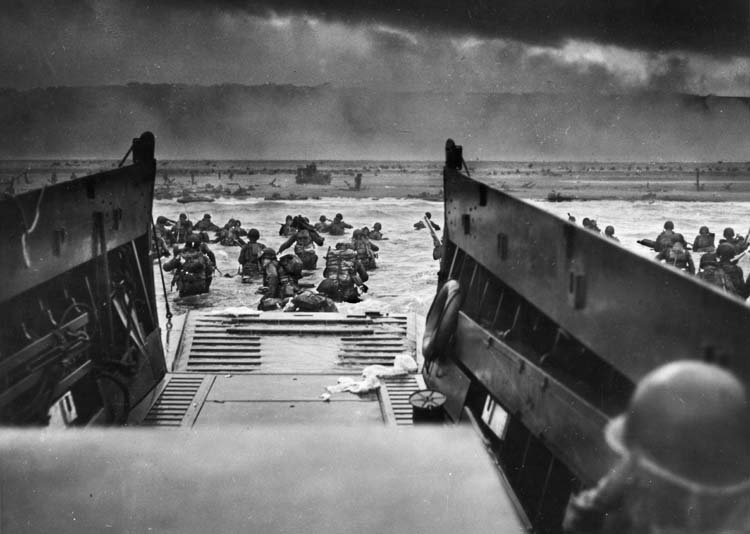
The 352nd contained a core of veterans who had gained gainsay experience on the Eastern Front end. After the germination of the division in the autumn of 1943, the troops expected to exist sent to fight the Russians simply shortly learned that they would exist sent to Normandy. They mistakenly believed it would be a relatively quiet assignment.
The men of the 352nd Sectionalisation realized by early summer that the take a chance for an Allied invasion in Normandy was likely. High-ranking High german officers grew anxious that the heights overlooking Omaha Embankment were vulnerable to capture by the Allies. By the morning of June 6, the beach was defended past elements of Colonel Ernst Goth's Grenadier Regiment 916, one of the toughest German units on the coast, every bit well equally gunners from the 352nd Arms Regiment.
When the fume from the bombers and naval guns lifted, it revealed the complete failure of the Allies to soften up the German positions. The B-17s, which had been designed for high-level bombing of strategic targets, had largely missed the marking and dropped most of their ordnance behind the German positions. As for the naval arms, it had failed to do serious damage to the well-engineered German fortifications. The bulk of the noisy rocket salvo fell harmlessly in the shallows in front end of Omaha. Despite the unparalleled display of firepower, German defenses were largely unscathed. It was an unexpected and ominous evolution.
Outright bad luck did non assist matters. When the DD tanks began launching, affairs speedily degenerated into a fiasco. Gear up afloat in fierce breakers, the Shermans foundered in high waves and sank to the bottom of the bounding main. Lucky crew members climbed out of the tanks before they went under; however, those who remained trapped inside the 33-ton behemoths perished. Just a relative handful of Sherman tanks, taken closer to shore by quick-thinking officers, succeeded in landing on the beach. For the grim chore of assaulting Omaha, the infantry was largely on its own.
As the assault boats plunged through the surf, the men crammed aboard suffered immensely. The choppy seas ensured that the GIs were drenched to the bone and violently seasick. Many of the Higgins boats were leaking desperately, and in an attempt to stay afloat the troops frantically bailed seawater with their helmets.
Near the western end of the embankment, Company A was right on target as it neared its assigned landing zone at Dog Light-green. But adjacent companies, whose landing craft were pushed off course by potent currents, were badly out of position. As the men of Company A prepared to become ashore, they did so without adequate flank support. Germans in the heavily dedicated Vierville describe concentrated their fire on the isolated visitor.
The entire operation began to unravel. Earlier the arts and crafts made landfall, they were taken under heavy fire. One unlucky landing craft inexplicably sank one,000 yards offshore, while the troops onboard activated their life vests and tried badly to stay afloat. Another ill-blighted craft abruptly disappeared in a violent fireball, the apparent victim of an enemy beat out.
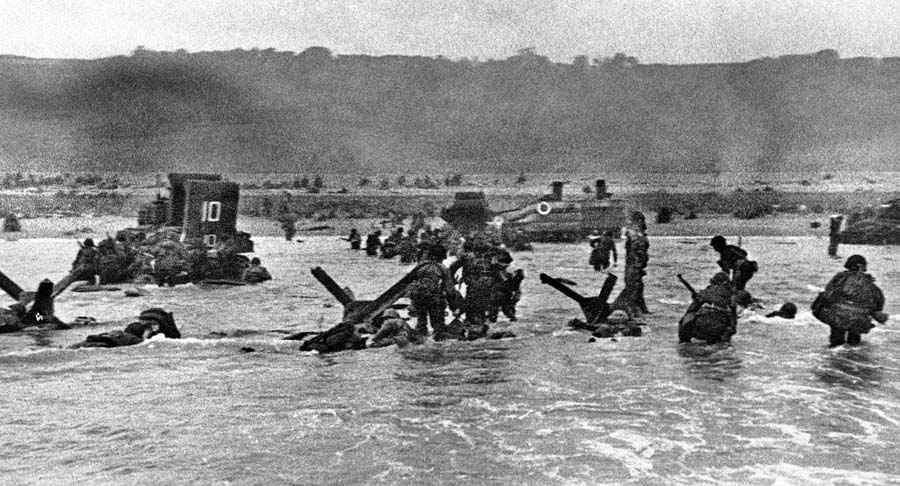
When the Higgins boats fabricated landfall and dropped their ramps, the horrific realities of gainsay manifested in seconds. German machine-gun fire swept through the craft. Scores of men were killed and wounded in a matter of minutes. Those even so on their feet struggled forwards through the water; as they did so, they endured a steady hail of motorcar-gun fire. Those who survived the enemy burn down crouched backside German antitank obstacles. Pinned downward in a deadly interlaced field of enemy automobile-gun fire, Company A was out of action.
To its left, Companies One thousand and F, which had been forced off target by the waves, came into the beach together, an inviting mass of targets for the German defenders of Les Moulins depict. As the companies waded ashore, they ran a terrifying gauntlet of enemy burn. Sergeant Henry Bare remembered the carnage as sickening. "My radio man had his caput diddled off three yards from me … the beach was covered with bodies, men with no legs, no arms," said Blank. "God it was atrocious."
The remnants of the two companies inched their way frontward across the beach to the seawall, which offered a measure of embrace from German machine-gun fire, but little protection from mortar and arms fire. When they ran into a coiled mass of barbed wire, the men were helplessly stalled. In the chaos of the landings, they had lost their Bangalore torpedoes and were left with no ways of forcing their way through the concertina.
Because getting off the embankment chop-chop was a paramount tactical objective, the men had been instructed to simply go on moving and go out the wounded to the medics. Obeying those orders would exit deep scars for survivors. Badly wounded men "would simply lay out in that location and scream until they died," recalled Sergeant John Robert Slaughter of Company D. Army medics who braved enemy fire to tend the wounded were universally regarded by their boyfriend soldiers as heroic saints. But the Germans paid no attention to the red crosses emblazoned on the medics' helmets. They fired at anyone moving on the beach.
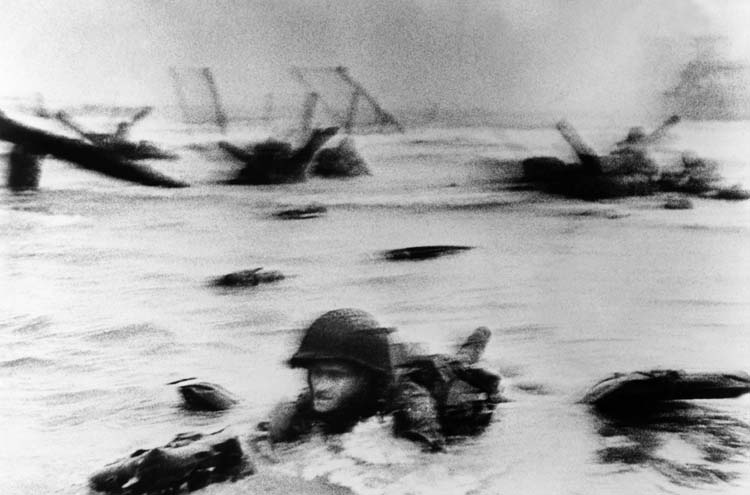
The muddled landings played havoc with unit cohesion. Heavy currents nudged Visitor East off course, and information technology came in with elements of the 1st Segmentation'south 16th Infantry. The embankment was littered with expressionless and dying American soldiers. Those fortunate enough to brand information technology to the shingle were trapped by a horrific maelstrom of enemy burn. Mortar rounds continued to autumn on their position, and officers desperately tried to get the men out of the killing zone. Company E's Helm Lawrence Madill, his left arm nigh torn off, stayed on his feet and shouted orders for the men to keep moving. As he sprinted across the embankment to retrieve armament, Madill was shot downwards. Only before he succumbed to his wounds, his last thoughts were for the safety of his men. Madill gasped, "Senior noncom, take the men off the embankment."
Without further reinforcement and firepower, simply surviving the ordeal was unlikely. As subsequent waves approached the beach, it was obvious that the entire assault on Omaha had turned into a nightmare, and nearly no one arrived at their assigned sector. When Company B hit the embankment, it was greeted with a scene of surreal horrors that survivors would never forget. Individual Harold Baumgarten witnessed a fellow soldier with a ghastly wound in his brow. "He was walking crazily in the water," said Baumgarten. "And so I saw him go down on his knees and start praying with his rosary chaplet. At this moment, the Germans cutting him in half with their deadly crossfire."
When Visitor M came ashore, it was accompanied by Brig. Gen. Norman Cota, the second in command of the 29th Division, and Colonel Charles Canham, the commanding officer of the 116th Infantry. Canham was keen to kill Germans personally. When he charged ashore with his Browning Automatic Rifle, he received a nasty wound to his paw. Refusing medical treatment, he drew his sidearm and stormed alee.
On the eastern one-half of Omaha Embankment, which was assigned to the 16th Infantry, the landings had gone no better. Private H.W. Shroeder was horrified past what he saw as the ramp on his landing arts and crafts dropped. He and his swain soldiers slowly worked their way across the embankment, using the massive hedgehogs for cover. When they finally reached the seawall, there was piffling room for more panicked men. "There were GIs piled two deep," recalled Shroeder.
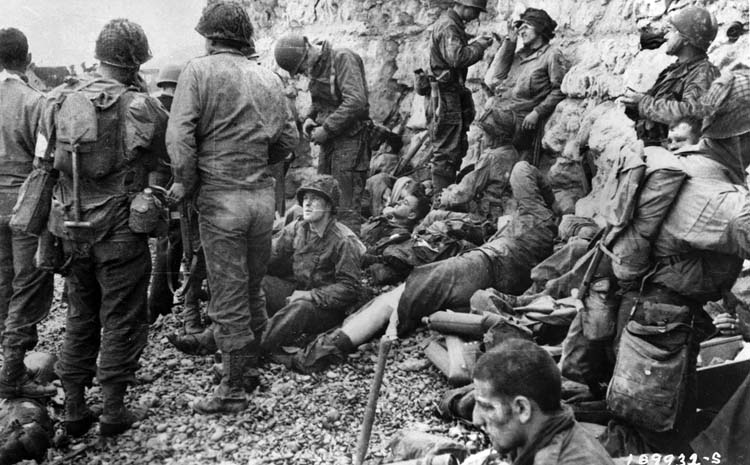
The disorganized companies of the 16th Infantry were badly mauled as they struggled forrard. Crouching backside the seawall, the survivors of Company F had lost well-nigh of their weapons in their effort to get out of the h2o. Equally for Company I, 1-third of its men had been killed. When Captain Joe Dawson of Company M came ashore, he was appalled by the sight. "Equally I landed, I constitute nothing but men and bodies lying on the shore," he recalled.
The set on troops also experienced a traffic jam with their vehicles. Demolition teams, which also had been decimated past enemy fire, had been able to blow only a one-half-dozen paths through the beach obstacles. The tanks, trucks, and bulldozers that had come ashore were trapped on the beach, easy targets for the Germans. The beachmasters halted further vehicle landings at 8:30 am until more paths could be opened.
For the Germans situated on the heights, the beach below presented a target-rich mass of men. At the German bunker known equally Widerstandsnest 62, Private Franz Gockel, whose car gun had been destroyed by an artillery shell, grabbed a rifle and resumed firing on the Americans scrambling for encompass on the beach below. When the GIs crowded behind the seawall, High german mortar teams targeted them. "They had waited for this moment and began to lay mortiferous burn down on preset coordinates forth the sea wall," said Gockel. As American landing craft began turning abroad from the beach, Gockel and his comrades thought the Americans were beginning to withdraw.
Despite the one-sided fight on the sand flats of Omaha Beach, German troops forth the residual of the Normandy coast were hard pressed. General of Artillery Erich Marcks, who commanded the LXXXIV Corps, found himself overwhelmed past simultaneous landings on 5 beaches in his front. He had e'er regarded Omaha as the weakest sector in his line, and information technology was obvious that he could expect no firsthand armor support. German air encompass was near nonexistent. Marcks threw forrard just a portion of his infantry reserves; information technology seemed that the assault on Omaha was existence handily repulsed.
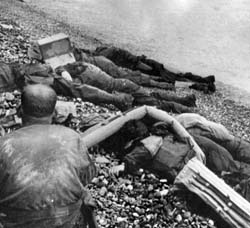
On the deck of the cruiser Augusta,Lt. Gen. Bradley, shocked by initial reports, was of much the same stance. Although the American landings on Utah had gone miraculously well and the British and Canadian troops were making expert headway in their sector, the assault on Omaha Embankment seemed to accept degenerated into a disastrous and bloody nightmare. Hardly any of the units had landed where they were supposed to land. What is more, the initial prey estimates were appalling and it appeared doubtful if the disorganized survivors would be able to push inland.
Bradley was giving serious consideration at mid-morning to pulling the plug on the entire operation at Omaha Beach and transferring subsequent waves to the British landing zones. The tactical solution to the bloody impasse on Omaha Beach came non from the superlative brass, but from intrepid officers, not-commissioned officers, and grunts; for example, when Colonel Canham arrived at the stalled line of GIs on the beach, he was a storm of energy. He shouted, cursed, and threatened the men to get them moving. Canham knew that if the set on troops remained paralyzed behind the seawall, they would make easy targets for enemy machine-gun and mortar teams, which had presighted every inch of Omaha Beach. Despite the high casualties that were sure to consequence if the attack was pressed frontwards, there was simply no other choice. "Get the hell off this damn beach and go kill some Germans!" he bellowed.
The captains of the U.S. destroyers stationed offshore were exasperated at the sight of the mauling experienced by the infantry. They took the initiative to motion their vessels closer to shore to furnish badly needed fire support. About a dozen destroyers risked grounding on the sandbars and delivered a punishing fire to German positions on the bluff.
Brigadier General Cota was equally conspicuous, rallying the demoralized Americans for a concluding button up the bluffs. Cota personally directed the placement of Bangalore torpedoes that blew a hole in the barbed wire to a higher place the seawall. He was one of the first men who charged through the gap. Rushing forward through a tempest of enemy mortar fire, Cota miraculously remained on his feet afterwards five men fell beside him. Realizing that the beach draws were also heavily defended to take by frontal attack, Cota ordered his men to storm the steep bluffs.
Junior officers and not-coms had already reached the same conclusion and began leading small groups of men in a desperate bid to climb the heights above the embankment. The momentum of the fight finally shifted when the troops, gripped with a powerful mix of fury, adrenaline, and the sheer will to survive, rushed forward in minor groups and punched through the defenses behind the seawall.
The hillside was heavily mined, and advancing infantry would pay dearly for every inch of footing. The minefields would come to be littered with mangled GIs who had fallen victim to the hidden killers. Merely every bit the Americans began locating and mark safe passages, the High german grip on the barefaced began to weaken. GIs rousted Germans from pillboxes, bunkers, and trenches by wildly shooting at whatever defender brave enough to make a run for it. With a measure out of vengeful irony, American troops turned captured machine guns on the backs of Germans who had made Omaha Beach a veritable slaughter pen.
Sergeant Warner Hamlett of the 116th and a team of men from Company D hitting the German positions with an assail that would be repeated all across the bluffs. The men inched their way betwixt German pillboxes, attacked the connecting trenches, and so worked their way to the rear of the pillboxes. The troops tossed mitt grenades through apertures then rushed inside to impale the survivors. "The bravery and gallantry of the soldiers was across conventionalities," said Hamlett.
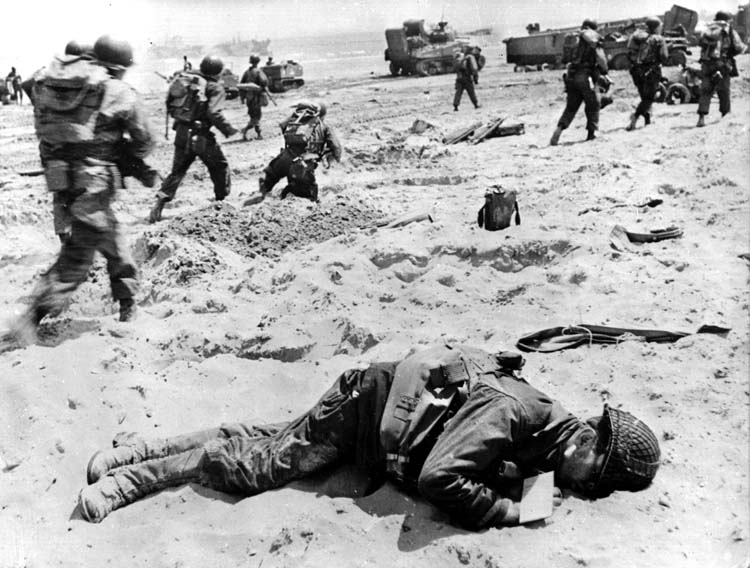
That morning and into the afternoon, boilerplate soldiers fought their fashion upwards the bluffs and pried the German language defenders loose. "Troops formerly pinned down on beaches Piece of cake Red, Easy Green, Fox Cherry-red advancing upward heights backside beaches," Maj. Gen. Leonard Gerow, the commander of the 29th Partition, reported at one pm.
Considerable tough fighting remained, but Omaha had finally been secured. Past mid-afternoon, troops from various units, including the 116th Infantry and elements of the 2d and 5th Ranger Battalions, were driving German troops from the coastal villages south of Omaha Beach.
The dearly bought landing site resembled a frightful charnel business firm. Hundreds of lifeless corpses rocked in the incoming tide and carpeted the beach. Sergeant Hamlett, after beingness wounded on the bluffs, limped for the shoreline to observe a medic. "As I painfully walked dorsum to the beach, thousands of parts of bodies lined information technology," he said. "There were floating heads, artillery, legs." Meanwhile, wearied Navy surgeons on ships at sea worked feverishly to save the wounded, calm the shell shocked, and amputate shattered limbs.
The Americans suffered 4,700 casualties at Omaha Beach. The ill-fated Company A of the 116th, which was virtually destroyed in the assault, suffered 96 percent overall casualties. Of the total Allied losses on D-Day, one-third had been sustained on the flats and bluffs of Omaha Embankment.
But such appalling personal sacrifice had secured a permanent lodgment into Nazi-occupied Europe. While American and Allied troops continued to press the attack into Normandy, landing craft ferried supplies from the fleet, eventually depositing a veritable mount of matériel on the 5 landing beaches. In the calendar week following Operation Overlord, the Allies had landed more than 300,000 men and 2,000 tanks in coastal French republic.
The epic struggle on Omaha Beach proved to be one of the costliest battles of World War 2, only it helped set in motion an inexorable chain of events that would pb to the collapse of the Third Reich. Rommel had been correct when he said that the state of war would be won or lost on the beaches.
For the American citizen soldiers who stormed the Atlantic Wall, D-Day left scarred bodies and seared memories. Those who survived the ordeal and so had to endure the xi-month drive from Normandy to the Elbe River that ended with Nazi Germany's surrender on May 8, 1945. Bob Slaughter, who had seen his young man soldiers in Company D of the 116th Infantry killed wholesale on the fateful morning of June 6, gave credit for victory to the American infantrymen who paid the ultimate cede on Omaha Beach. "They laid it all on the line, and they won the war," he said.
How Many Doctors Were Called Up For D-day Service,
Source: https://warfarehistorynetwork.com/2020/01/28/d-day-landing-at-omaha-beach/
Posted by: whittyinectelithe63.blogspot.com


0 Response to "How Many Doctors Were Called Up For D-day Service"
Post a Comment